Continuing the series on innovative games that revolve around agile, this time I’d like to introduce you to the Cynefin Lego Game from Agile42. I had started (in 2011?) to discuss Cynefin, but with little talent, I realize today. I hadn’t approached it the right way. I believe and hope I’ve progressed since then, and I think I’ve better organized these ideas in my head. Cynefin is a very interesting framework for thinking that addresses managers, leaders or other people in decision-making, in the practices to implement to respond to various situations. I find it quite fascinating.
To get you interested in this, I suggest you dive into the Cynefin Lego Game (I plan to offer it at various events in the coming months, or in my training courses), because there’s nothing like a game for learning; Confucius supposedly said: “tell me and I will forget, show me and I will remember, involve me and I will understand.” To which Aristotle would have replied: “We must play to become serious.”
To fully understand the value of this game I suggest reading this article by Mary Boone1. I’m translating the summary table below (and I’ll translate the entire thing as soon as possible).
Translation 1: Decision-making according to context, the leader’s guide
Excerpt from the article: a leader’s framework for decision making1 (Framework for decision-making for leaders).
Simple
Context Characteristics
- Repeating patterns at regular and consistent intervals.
- Cause-and-effect relationships obvious to everyone. The right answer is self-evident.
- There are no unknowns, the answer is known. (known knowns)
- Management based on facts, indicators.
The Leader’s Job
- Sense, categorize, respond
- Ensure the right processes are in place.
- Delegate
- Use best practices.
- Communicate clearly and directly.
- Understand that extensive interactive communication is not necessarily required.
Warning Signs
- Complacency and comfort.
- Desire to make simple things complicated.
- Automatic responses.
- Watch out for habits, muscle memory, without reflection.
- Remaining fixed on (usual) best practices despite the fact that the context has changed.
Responses to Warnings
- Create communication channels to allow questioning of orthodoxy.
- Stay connected (informed) without micromanaging.
- Don’t assume things are simple.
- Understand the benefits and limits of best practices.
Complicated
Context Characteristics
- Expert diagnostics are necessary.
- Cause-and-effect relationships can be found but are not obvious, require expertise. Multiple good answers are possible.
- There are unknowns, but the answers could be known. (known unknowns)
- Management based on facts, indicators.
The Leader’s Job
- Sense, analyze, respond
- Create panels of experts.
- Listen to contrary opinions.
Warning Signs
- Experts are too sure of their solutions, or of applying a previous solution.
- Paralysis during analysis.
- No consensus within the expert panel.
- Non-expert viewpoints are dismissed and excluded.
Responses to Warnings
- Push stakeholders or external people to question expert opinions, and combat habits (muscle memory).
- Use games or workshops to push people to think differently.
Complex
Context Characteristics
- Unpredictable flow of events, information, etc.
- No right answer, instructive patterns will emerge.
- There are unknowns, we don’t know if the answers could be known. (unknown unknowns)
- Many competing ideas.
- Need for creative and innovative approaches.
- Management based on patterns, thinking patterns, practices.
The Leader’s Job
- Probe, sense, respond
- Create environments that allow practices to emerge.
- Increase the level of interaction and communication.
- Use methods that allow new ideas to emerge: brainstorming, open discussions, defining a framework (translator’s note: to free thinking within it), stimulating relationships, encouraging dissent and diversity, managing starting conditions (translator’s note: providing rich ground for reflection), seeking, tracking innovations, emerging ideas.
Warning Signs
- Temptation to fall back into command & control habits.
- Temptation to observe facts, indicators, rather than letting new practices emerge.
- Desire to accelerate problem solving or exploit emerging solution paths.
Responses to Warnings
- Be patient and allow time for reflection.
- Support approaches that encourage strong interaction and thus favor emerging practices.
Chaotic
Context Characteristics
- Heavy turbulence.
- No cause and effect, nothing seems connected, we don’t know where to find the right answer.
- We are in the unknown. (unknownable)
- Many decisions to make and no time to think.
- High tensions.
- Management based on patterns, thinking patterns, practices.
The Leader’s Job
- Act, sense, respond
- Look for what works rather than seeking ready-made answers.
- Make decisions, act immediately (command & control), to restore order.
- Provide clear, concise and direct communication.
Warning Signs
- Applying a command and control approach too long, more than necessary.
- Leader cult.
- Missing improvement opportunities through new practices.
- Persistence of chaos.
Responses to Warnings
- Set up mechanisms (like two teams in parallel on the same subject) to take advantage of opportunities offered in this chaotic environment.
- Surround yourself with advisors to question your viewpoint once the crisis has passed.
- Work to shift the context from chaotic to complex.
Now I suggest a practical implementation through a game.
Translation 2: Cynefin Lego Game by Agile 42
Translation of the article: Cynefin Lego Game
Context
The Cynefin Lego Game is part of the agile management training by Agile42. It is licensed under Creative Commons Attribution-Share Alike 3.0.
What is it?
A game to allow you to experience the 5 domains of Dave Snowden’s Cynefin thinking system.
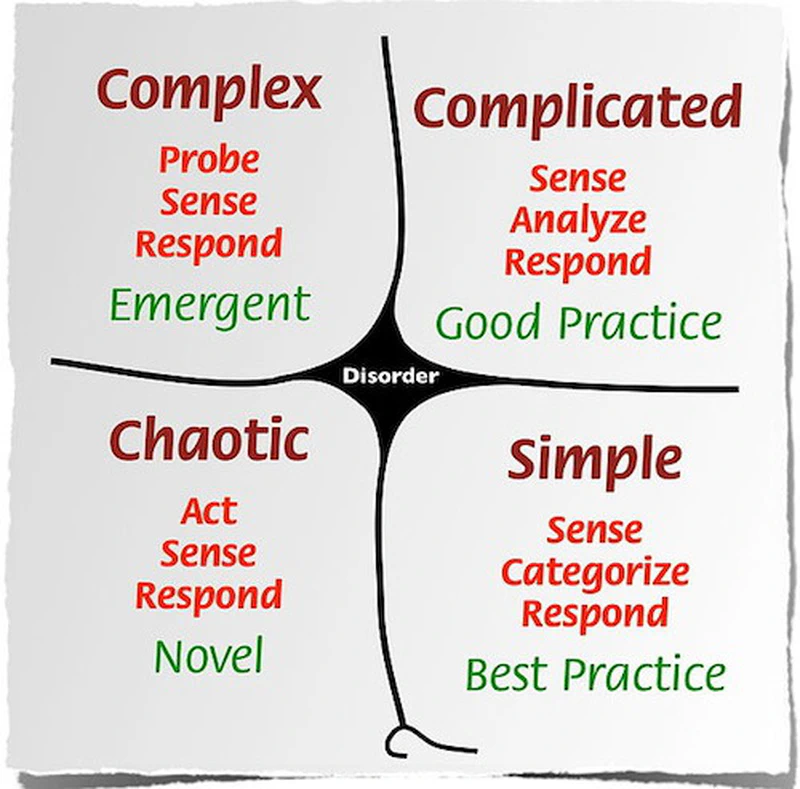
Using Legos, you will be confronted with 4 exercises whose problem and context are related to a simple, complicated, complex or chaotic system. Although this game doesn’t offer you a complete overview of the sense-making framework, it is well suited for a first impression, and may push you to want to know more! Finally, while Cynefin is at the heart of the workshop, the conclusions and discussions won’t necessarily be tied to this model.
Why use it?
When you lead or manage agile transitions, it’s important to know what type of system you’re facing. Playing this game allows you to learn to decode what’s happening in terms of organizational structures and communication in the system you’re confronted with. Once this analysis is done, you’ll adapt your communication in coherence with the decoded system, and you’ll propose better adapted tools.
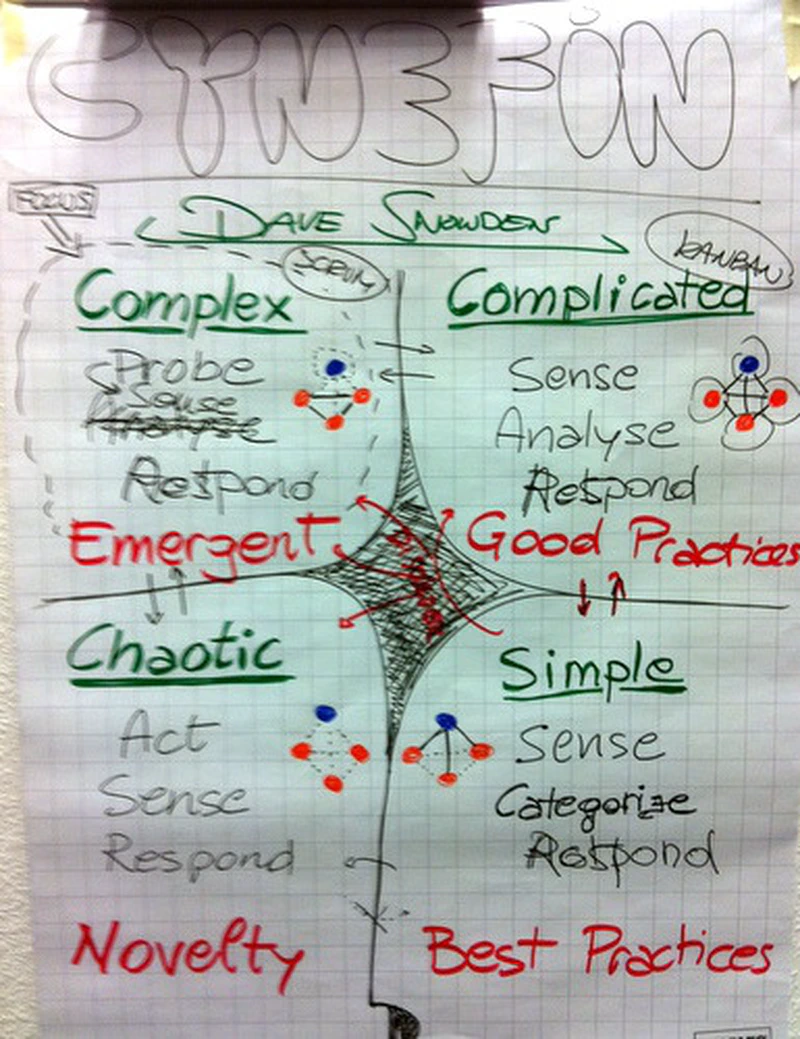
Duration
The game should not exceed 60 minutes.
Materials and environment
Tables for groups of 3 or 4, about 200 Lego bricks of 6 to 10 colors and different sizes (and special bricks: flowers, wheels, …) per table.
Instructions
Draw the diagram on a sheet (paperboard). Only draw the lines in the middle, you’ll fill in the diagram as the exercises progress (people should experience and conceptualize the domains with you).
You play one exercise per domain, as described below, for each exercise:
- Explain the rules until there are no more questions.
- Start the exercise at the same time on all tables.
- Time it but don’t impose a maximum time.
- Note the shortest and longest time.
- When all teams are finished, give them 2 minutes of retrospective and discussion.
- Share conclusions and debrief.
- Fill in the domain in the diagram in relation to the teams’ conclusions.
- Draw the communication modes and ways of making decisions observed during the exercise.
Exercise 1: Simple
The challenge
Sort the bricks by colors, as fast as possible. Create a pile dedicated to all special elements. Decide within your team what are the special elements.
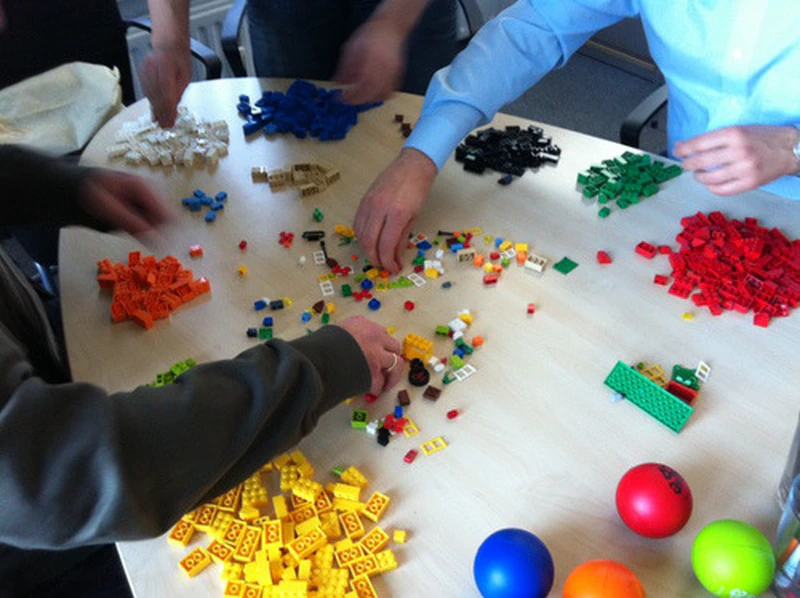
Debriefing
- How much time spent preparing?
- How did communication go? How many leaders and doers in the team?
- You’ll note the appearance of best practices in each of the groups.
- Analyze the communication modes and the way people made decisions and agreed. You should note a very directive top-down pattern, one person probably proposed “THE” way to solve the problem and the others followed. Not much pair communication during the exercise, at least not about how to do things, but rather about operational aspects.
Exercise 2: Complicated
The challenge
Build a structure as fast as possible according to the following rules:
- At least 20 bricks high.
- A regular color pattern.
- Each new element added to the structure must be smaller than the one below it.
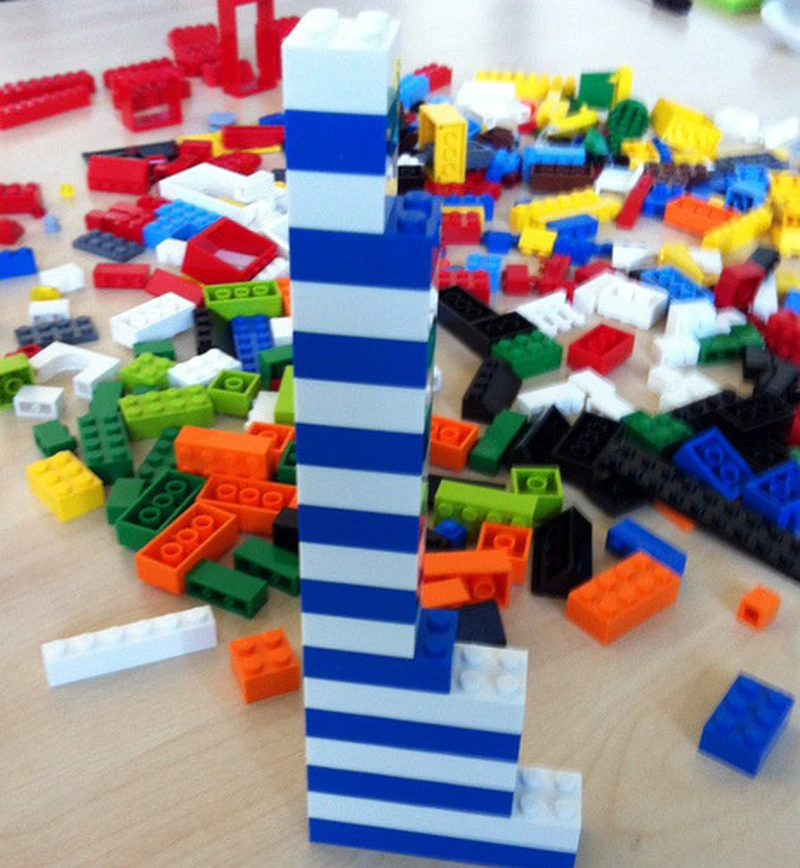
Debriefing
- What did you feel compared to the “simple” problem?
- How much time spent preparing?
- How did communication go? How many leaders and doers in the team?
- In this framework you should observe that each team adopted different practices, producing different results. So these are not “best practices” but “good practices.”
- Analyze the communication modes and the way people made decisions and agreed. You should see an “expert communication” pattern: where everyone tries to propose their solution. Teams can at this stage enter a phase of analysis-paralysis, consider this as an invitation to discuss the opportunity of a facilitator role within the team.
Exercise 3: Complex
The challenge
Decide in 30 seconds to build either an animal or a vehicle. After that you’ll work according to the following rules:
- As in exercise 2 you’ll need to propose a regular color pattern
- Each color (of brick) will only be handled by one team member.
- You’re not allowed to speak!
- Every minute, you must change tables, taking your work with you, but not the materials!
Debriefing
- What did you feel compared to the “simple” or “complicated” problem?
- How did communication go? How many leaders and doers in the team?
- What type of feedback did you have to guide you toward the solution?
- Would it have made a difference if you had had 5 minutes to discuss and prepare before starting to build?
- Here you should easily note emergent behaviors, many people are surprised to discover that the ban on speaking allowed them to avoid long and futile discussions, and conversely that starting to build something together sparked new ideas and inspiration at each step. Compare with the time spent in previous exercises, normally it shouldn’t differ much, despite the fact that the challenge is complex.
Exercise 4: Chaotic
The challenge
The objective and framework are the same as in the previous exercise, but you must build a house, a building or a factory. In addition, randomly, the facilitator will touch a group member’s shoulder and indicate another table. This person must immediately join this other team.
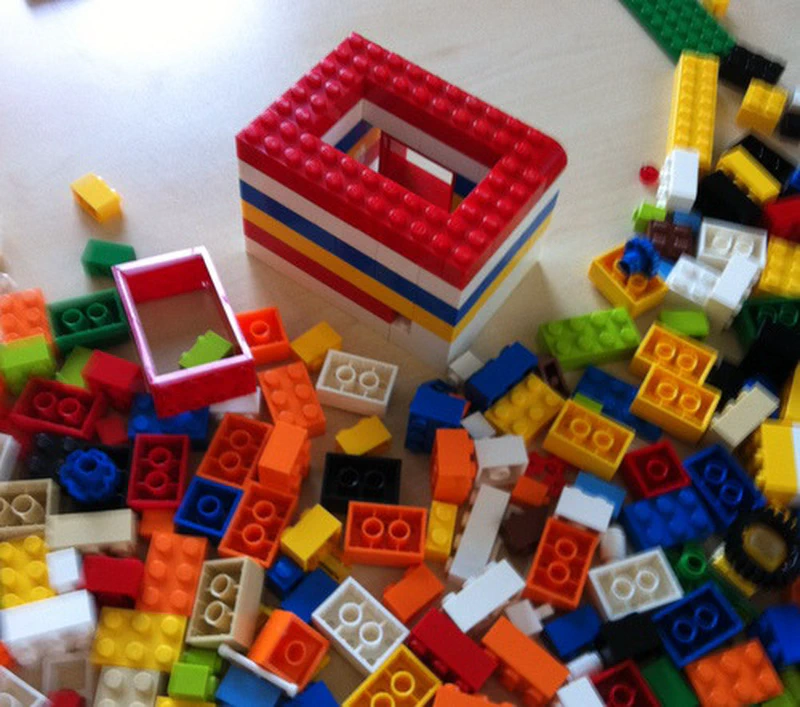
It’s still not allowed to speak. For each teammate you have leave the team, you should offer a new one who joins it, but not immediately. (This will lead them to think they’re missing a person to manage a certain color, which is not true, if you read the rules. Don’t tell them that this is not true).
Debriefing
- What did you feel compared to the “simple” or “complicated” or “complex” problem?
- How did communication go? How many leaders and doers in the team?
- How did you perceive losing a team member? How did you integrate into another team?
- You should be able to appreciate that communication has become almost nonexistent, that people have abandoned the idea of communicating, they prefer to start doing things (and get stopped by others (act and sense)). Notably, people should feel -unlike the previous exercise- completely demotivated and frustrated.
Notes
The simple exercise usually offers a quick solution. One player proposes something obvious, and the others follow.
The complicated exercise requires some planning, typically everyone suggests a solution, a quick decision is made and the process is adapted according to what happens during fabrication.
The complex exercise: its result is not better with longer preparation. The right process emerges and keeps adapting. The sooner the team starts building, the sooner it feels comfortable. It helps if there’s convergence within the team on the appearance of the animal or vehicle being built.
The chaotic exercise leads to funny surprises, sometimes to bad results (look at the building without a roof in the image). People don’t feel comfortable all the time, the solution takes time to emerge. Especially for managers it’s sometimes a discovery: “so that’s how it feels when you change teams…”
Links
Cynefin framework: http://en.wikipedia.org/wiki/Cynefin
Dave Snowden’s blog: http://www.cognitive-edge.com/blogs/dave/
-
The original article is no longer accessible, it was located at: http://www.mpiweb.org/CMS/uploadedFiles/Article%20for%20Marketing%20-%20Mary%20Boone.pdf. I had saved the pdf that you have linked. ↩︎ ↩︎